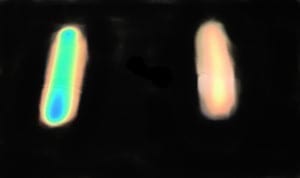This activity formed part of an investigation in a Curriculum for Excellence, Sciences, Planet Earth, Biodiversity & Interdependence to support Experience & Outcome SCN 2-01a, I can identify and classify examples of living things, past and present, to help me appreciate their diversity. I can relate physical and behavioural characteristics to their survival or extinction. Similar activities could be used when teaching SCN 0-15a, Through creative play, I explore different materials and can share my reasoning for selecting materials for different purposes. and SCN 1-15a, Through exploring properties and sources of materials, I can choose appropriate materials to solve practical challenges.
Thermochromic sheet is a wonderful way for children to “see” heat. The film (available from several suppliers) is black at room temperature but changes colour at temperatures above 27oC. The sheet gives a beautifully visual indication of changes in temperature and so it has uses in the primary school where measuring temperatures by other means may not yield conclusive results. The children may already be familiar with LCD type thermometers for measuring forehead, bath and bedroom temperatures (Figs. 1a, b & c).



Figures 1a, b & c – LCD (liquid crystal display) themometers
At our Primary Residential Courses this session a sheet of thermochromic film was given to each participant and used in a workshop about heat loss in animals. We filled universal bottles with water from the hot tap and wrapped one in fur fabric. (Figure 2a). The sheet of themochromic film laid over this arrangement is shown in Figure 2b.


Figures 2a & b – Universal bottles – with and without fur fabric and then with thermochromic paper laid over top.


Figures 3a & b – Gloved and ungloved hand placed on film then removed.
A word of warning
Children may have difficulty understanding what they are seeing on the sheet and an introductory activity may be needed to make this clear. If you wear a glove on one hand which of your hands feels warmer? Yes, the one with the glove (Figures 3a & b). But which hand shows up bigger and brighter on the thermochromic film? The one that is losing more heat energy i.e. the ungloved hand. A big, bright pattern indicates that the object is losing heat energy. An additional question about the bottles could be asked – If both bottles start out with the same amount of heat energy, which is the one that would be more likely to cool down more quickly?
Thermochromic sheet can also be used to show up heat energy generated by friction (SCN 2-07a). Usually children are asked them to rub their finger on the desk to ‘feel the heat’. This activity allows children to both ‘feel’ and ‘see’ the heat (enegy). Covering the fingers with different materials produces interesting results. Therefore a comparison of the heat patterns produced by rubbing different surfaces on the thermochromic film may be possible. See the video on our website (coming soon).
There is vast scope for extension work with this versatile material. We will return with more ideas in future issues.



